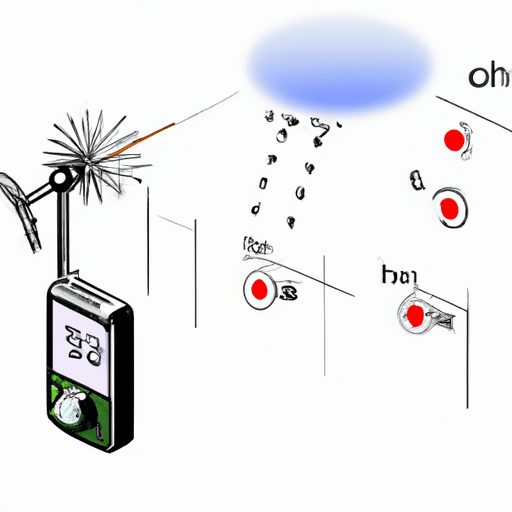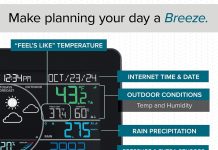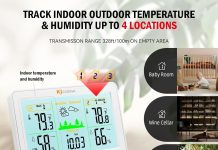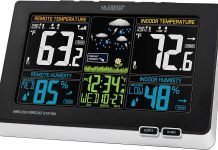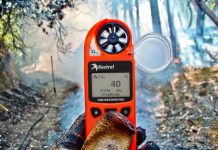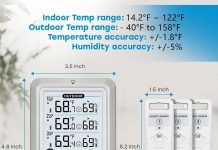Curiosity surrounds the lifespan of batteries in home weather stations. We all know the frustration that comes with dead batteries at the most inconvenient times. So, in this article, we will uncover the mystery and shed some light on the longevity of home weather station batteries. Join us as we explore the factors that influence their lifespan and discover helpful tips to ensure you’re never caught unprepared during unexpected weather events. Get ready to equip yourself with the knowledge to keep your weather station running smoothly for years to come.
Review contents
Factors Affecting Battery Life
When it comes to home weather stations, there are several factors that can influence the battery life. Understanding these factors can help us maximize the longevity of our batteries, ensuring our weather stations continue to function efficiently. The key factors that affect battery life are the type of weather station, the battery type, usage patterns, and operating conditions.
Type of Weather Station
The type of weather station we choose can have a significant impact on battery life. There are two main types of weather stations: wireless and wired.
Wireless Weather Stations
Wireless weather stations are popular for their convenience and ease of installation. However, they do require batteries for both the console/display unit and the sensors. The battery life for these units will depend on a variety of factors, including the quality of the weather station and the frequency of data transmission.
Wired Weather Stations
In contrast, wired weather stations do not rely on batteries for their sensors. The sensors are directly connected to the console/display unit through wires, eliminating the need for batteries in the sensors. This can be advantageous for those concerned about battery life, as the console/display unit is the only component that requires batteries.
Battery Type
The type of battery we choose for our weather station can have a significant impact on its lifespan. There are three common types of batteries used in weather stations: alkaline batteries, lithium batteries, and rechargeable batteries.
Alkaline Batteries
Alkaline batteries are a popular choice due to their widespread availability and affordability. They are suitable for most weather station models and offer a decent lifespan. However, the actual lifespan of alkaline batteries can vary depending on usage patterns and operating conditions.
Lithium Batteries
Lithium batteries are known for their extended lifespan compared to alkaline batteries. They are particularly suitable for extreme temperatures, making them a great option for weather stations in regions with harsh weather conditions. However, it’s essential to consider the effect of usage patterns on the lifespan of lithium batteries.
Rechargeable Batteries
Rechargeable batteries are an eco-friendly choice that can be an excellent long-term investment. They require an initial investment in a charger and rechargeable batteries but can save money in the long run. However, it’s crucial to note that rechargeable batteries may have a shorter lifespan compared to alkaline or lithium batteries.
Usage Patterns
Another crucial factor that affects battery life is our usage patterns with the weather station. How frequently we transmit data, the intervals at which we collect data, and additional sensor usage can all contribute to the battery drain.
Frequency of Data Transmission
If we have our weather station set to transmit data frequently, it may impact our battery life significantly. Transmitting data more frequently can result in higher battery consumption, reducing the overall lifespan of the batteries.
Data Collection Intervals
Similarly, the intervals at which we collect data will affect battery life. If we have our weather station collecting data at shorter intervals, it will require more energy, leading to a shorter battery lifespan. Adjusting the data collection intervals according to our needs and preferences can help optimize battery usage.
Additional Sensor Usage
Many weather stations offer the option to add additional sensors to measure various parameters like wind speed, rainfall, or UV radiation. While these additional sensors can provide valuable data, they may also consume more battery power. It’s important to consider the impact of these additional sensors on overall battery life and determine if they are necessary for our specific needs.
Operating Conditions
The operating conditions in which our weather station is installed can greatly affect battery life. Factors such as temperature, humidity, and extreme weather conditions all play a role in the overall lifespan of the batteries.
Temperature
Extreme temperatures can have a significant impact on battery life. Both high and low temperatures can cause batteries to degrade faster, reducing their overall lifespan. It’s important to choose batteries that are suitable for the temperature range in which our weather station will be operating to ensure optimal battery performance.
Humidity
Humidity can also impact battery life, especially if the weather station is exposed to high levels of moisture. Excessive humidity can cause batteries to corrode, leading to reduced performance and shortened lifespans. Taking steps to protect the weather station from excessive moisture can help mitigate this issue.
Extreme Weather Conditions
In areas prone to storms, heavy rain, or snow, the durability of the weather station batteries becomes crucial. Extreme weather conditions can put additional stress on the batteries, potentially causing them to drain faster or experience issues. Choosing a weather station model with adequate protection measures for extreme weather conditions can help ensure the longevity of our batteries.
Wireless Weather Stations
For wireless weather stations, it’s important to consider the battery life for both the console/display unit and the sensors.
Battery Life for Console/Display Unit
The console/display unit of a wireless weather station is responsible for receiving and displaying the data collected by the sensors. The battery life of the console/display unit will vary depending on factors such as the quality of the unit, the battery type used, and the frequency of data transmission. Checking the manufacturer’s specifications and reviews can help us gauge the expected battery life for the console/display unit.
Battery Life for Sensors
In wireless weather stations, the sensors are usually located outdoors and require batteries to function. The sensor batteries can be influenced by factors such as the battery type used, data transmission frequency, and operating conditions. It’s important to choose reliable batteries and monitor their lifespan to ensure uninterrupted data collection.
Wired Weather Stations
With wired weather stations, the battery life concerns are primarily focused on the console/display unit, as the sensors do not require batteries.
Battery Life for Console/Display Unit
In wired weather stations, the console/display unit is responsible for receiving and displaying the data collected by the sensors. Since the sensors are directly connected to the console/display unit through wires, they do not require batteries. This eliminates the need to worry about sensor battery life. However, it’s essential to consider the battery life of the console/display unit when choosing a wired weather station model.
Alkaline Batteries
Alkaline batteries are commonly used in weather stations due to their availability and affordability. Here are some factors to consider when using alkaline batteries in a weather station.
Typical Lifespan
The typical lifespan of alkaline batteries in a weather station can vary depending on factors such as usage patterns and operating conditions. On average, alkaline batteries may last anywhere from three months to a year, but this lifespan can be influenced by various factors.
Influence of Usage Patterns
As mentioned earlier, our usage patterns, such as data transmission frequency and intervals, can impact the lifespan of alkaline batteries. Transmitting data frequently or collecting data at shorter intervals can result in faster battery drain. It is important to find the right balance between data collection needs and battery usage to maximize the lifespan of alkaline batteries.
Impact of Operating Conditions
Operating conditions, such as temperature and humidity, can also affect the lifespan of alkaline batteries. Extreme temperatures, both hot and cold, can cause alkaline batteries to drain faster. Similarly, excessive humidity can lead to battery corrosion, reducing their performance. Taking steps to protect the weather station from extreme operating conditions can help preserve the lifespan of alkaline batteries.
Lithium Batteries
Lithium batteries offer an extended lifespan compared to alkaline batteries and are well-suited for specific weather station requirements. Let’s explore their advantages and considerations.
Extended Lifespan Compared to Alkaline Batteries
Lithium batteries have a longer lifespan compared to alkaline batteries. They can last significantly longer, making them a popular choice for weather stations, especially in areas with harsh weather conditions. Choosing lithium batteries can provide peace of mind, knowing that the batteries will last longer before needing replacement.
Suitability for Extreme Temperatures
One of the major advantages of lithium batteries is their suitability for extreme temperatures. They perform well even in extremely hot or cold conditions, making them ideal for weather stations in regions with harsh climates. This feature ensures that the batteries maintain their performance and longevity, even in challenging weather conditions.
Effect of Usage Patterns
While lithium batteries have an extended lifespan, it’s important to note that usage patterns can still impact their longevity. Transferring data frequently or collecting data at shorter intervals can still result in faster battery drain, albeit at a slower rate compared to alkaline batteries. Monitoring the usage patterns and adjusting the data collection intervals accordingly can help optimize the lifespan of lithium batteries.
Extreme Weather Conditions
Extreme weather conditions can put additional stress on weather station batteries. Let’s explore the considerations for battery durability and protection measures.
Battery Durability During Storms, Heavy Rain, or Snow
In areas prone to storms, heavy rain, or snow, it’s crucial to ensure that the weather station batteries can withstand these conditions. Extreme weather can lead to water damage or iced batteries, potentially causing malfunction or reduced lifespan. Choosing a weather station model with adequate protection against water ingress and ice formation can help safeguard the batteries.
Protection Measures for Weather Stations
To ensure the longevity of weather station batteries, it’s important to take appropriate protection measures. This can include using weather station models with water-resistant or waterproof features, covering the weather station during extreme weather events, and implementing proper sealing measures to prevent moisture or water intrusion. Additionally, proactive maintenance, such as regular cleaning and inspection, can also contribute to battery longevity.
In conclusion, several factors affect the battery life of home weather stations. The type of weather station, battery type, usage patterns, and operating conditions play significant roles in determining how long the batteries will last. By understanding these factors and making informed decisions, we can ensure that our weather stations continue to provide reliable data without frequent battery replacements. Whether it’s choosing the right battery type or considering protection measures, being mindful of battery life can enhance the overall functionality and longevity of our home weather stations.

